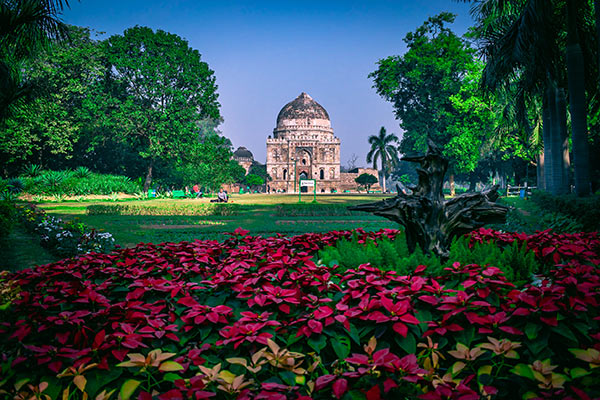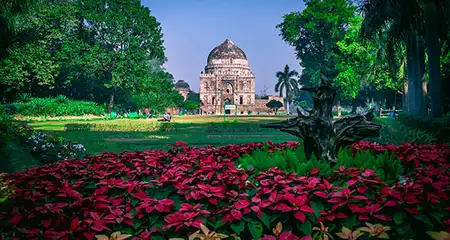Lodhi Gardens is a sprawling green park located in the heart of Delhi. It houses the mausoleums of two Delhi Sultanate rulers, namely Mohammed Shah and Sikander Lodhi, along with other structures. Boasting of impressive architecture and impeccable natural beauty, the garden and the structures within it echo the national capital’s illustrious tryst with history. The architectural heritage of around 500 years and the serene green setting make Lodhi Gardens a prime attraction in Delhi. Make sure to book your hotels in Delhi in an area that gives you easy access to this green oasis.
Want to know more about this heritage garden in Delhi? This blog has all the details including the history, architecture, timings, entry fee, and the things to see at Lodhi Gardens, Delhi.
Lodhi Garden, Delhi Information:
| Location | Lodhi Estate, New Delhi |
| Type | City Park |
| Formerly Known as | Lady Willingdon Park |
| Origins | 1444 |
| Area | 90 acres |
| Timings | 5:00 am to 8:00 pm (April to September); 6:00 am to 8:00 pm (October to March) |
| Entry Fee | Free |
| Still/Video Camera | Free |
| Nearest Metro Station | Jorbagh Metro Station and Lok Kalyan Marg Metro Station |
Lodhi Gardens: History
Lodhi Gardens aka Lodi Gardens traces its history back to 1444 when the tomb of Mohammed Shah, a Sayyid Dynasty ruler of the Delhi Sultanate, was erected here by his son and the last ruler of the dynasty, Ala-ud-din Alam Shah. Another significant tomb located in the area is that of Sikander Lodi from the Lodi Dynasty, which was built in 1517 by his son Ibrahim Lodi. Several other structures were also built here during the rule of the Sayyids and Lodis. When Emperor Akbar occupied the throne of Delhi, he made use of the Lodhi Gardens area as an observatory and stored records in a library built for this purpose.
Over a period of time, the area around these tombs developed into two villages. It was only in 1936, when the British were in power, that the villagers were removed to renovate the garden. Lady Willingdon, the wife of Marquess of Willingdon (the then Governor General of India) landscaped the area and turned it into an attractive garden. The garden was officially inaugurated in 1936 and was given the name Lady Willingdon Park to honor her efforts.
When the country gained independence in 1947, it was renamed as Lodhi Gardens. In 1968, the garden underwent re-landscaping by Joseph Stein, an American architect who also established a glasshouse in the garden.
Lodhi Gardens Architecture
Lodhi Gardens cover an area of over 90 acres and houses many 15th-century structures that display spectacular architectural beauty. The mausoleum of Mohammed Shah features Islamic and Hindu architectural styles. Designed with eight small domed structures or chattris, each adorned with a lotus finial, ornate pinnacles at the corners, a huge central dome, and an octagonal chamber, the tomb is a sight to behold.
The mausoleum of Sikander Lodi draws inspiration from Mohammed Shah’s tomb. Built in the Indo-Islamic style, it also features an octagonal design with a central dome, but without any chattris. The mausoleum stands as an enclosed edifice with a domed entryway and has Mughal architectural designs on its walls. It is considered to be the first enclosed garden tomb in India.
Lodhi Gardens: Today
Today, Lodhi Gardens is one of the top historical places in Delhi. It is also a favorite spot for local joggers, morning walkers, and yoga enthusiasts. The garden is also a preferred picnic spot for the family crowd while the tranquil ambiance makes it one of the best places for couples in Delhi to spend some romantic moments together.
In addition to the 15th-century mausoleums and other structures, you can also find over 50 species of butterflies and birds and 100 plus species of trees in this park. At present, the Archaeological Survey of India maintains the garden. A small area of the garden has been demarcated as the National Bonsai Park. Many groups and organizations in Delhi conduct heritage walks in this garden.
Things to See in Lodhi Gardens
In addition to the mausoleums of the two Sultans, there are several other edifices that are worth a visit, such as:
- Bara Gumbad or Big Dome, a huge rubble dome which is believed to have been built in 1490 by Sikander Lodi
- The three-domed mosque located in the Bara Gumbad complex
- Shish Gumbad or Glazed Dome, a tomb that is believed to be built by Ibrahim Lodi and decked with enameled blue tiles
- Athpula or Eight Pier Bridge, a beautiful 16th-century stone bridge constructed during Emperor Akbar’s reign, consisting of seven arches and supported by eight columns
- A lake
- A glasshouse
- National Bonsai Park
Lesser Known Facts about Lodhi Garden
- One of the gateways dating back to the British era is still in use.
- The New Delhi Municipal Council has attached QR codes to 100 species of trees in the gardens in order to prevent anyone from cutting them.
Attractions near Lodhi Gardens
- Khan Market (1.2 km)
- Purana Qila (2.6 km)
- National Handicrafts and Handlooms Museum (2.8 km)
- Rashtrapati Bhavan (3.1 km)
- Humayun’s Tomb (3.1 km)
- National Zoological Park (3.2 km)
- Safdarjung Tomb (3.7 km)
- India Gate (3.8 km)
- Connaught Place (4.5 km)
- Jantar Mantar (4.6 km)
- Dilli Haat (5.4 km)
Lodi Gardens in Delhi is an awesome place to spend some time in a historical setting. Once you are done exploring the attractions within the park, head out to the nearby Khan Market and shop to your heart’s content. The Lodi- the Garden Restaurant, situated near Gate No. 1 is an added attraction where you can enjoy a sumptuous alfresco dinner.






















